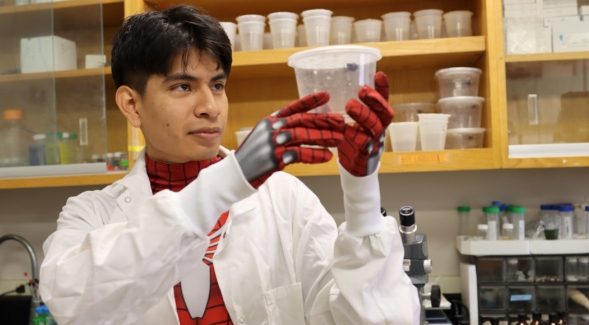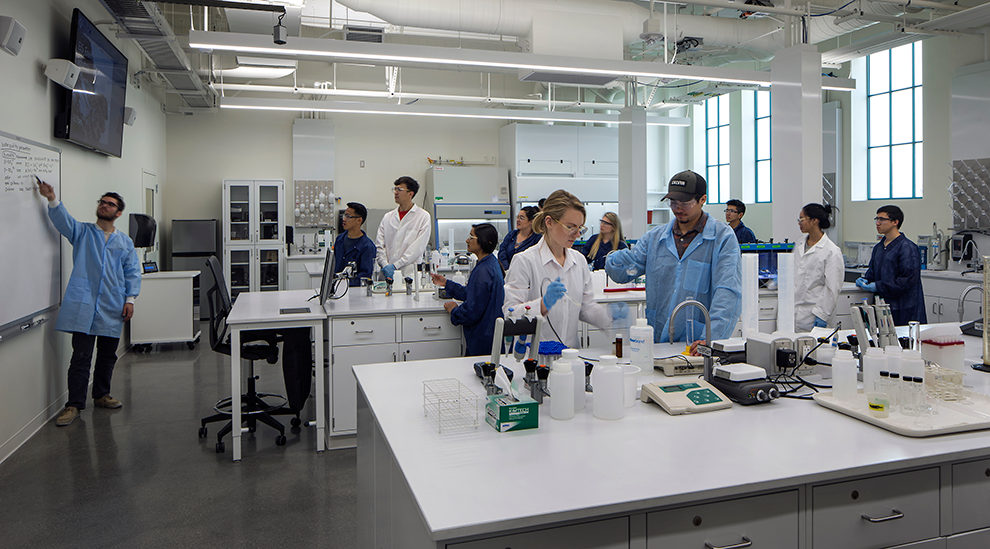SDSUxCOMIC-CON: Engineering His Spidey Senses
Spider-Man enthusiast Francisco Botello combines his love for his favorite superhero and his mechanical engineering major through his research on spider silk.

A giant green Hulk that smashes things? Total fantasy. A magic lasso that forces you to tell the truth? Scientifically impossible.
But being able to swing from buildings with spider silk?
"Absolutely realistic," said San Diego State University student Francisco Botello. "Two millimeters of silk are able to hold up to 900 pounds, so Spider-Man having super strength and weighing 160? That’s nothing.”
This Comic-Con season, Botello is here to tell you that the mechanics Peter Parker uses as Spider-Man are in fact possible. He would know: he studies the mechanical strength of spider silk.
As the rising fourth-year mechanical engineer walks around the lab wearing his Spider-Man-patterned backpack, he names off different species of spiders in different areas of the room: black widow, nephila, silver argiope, golden orb weaver. He learned these names long before his participation in the lab.
“When I was younger, I loved the Spider-Man cartoon series so much that I would go around collecting spiders and analyzing the different species,” Botello said.
As a child, Botello says he immediately identified with Spider-Man’s secret identity, Peter Parker: ”He was a nerdy high school kid who had a passion for science and tried to do his best to help other people. I wasn’t the most popular either and looked like him, so I related to him in that way.”
When Botello read a NewsCenter article his first year at SDSU on spider silk research, he emailed Gregory Holland, a professor of analytical chemistry and the head of the lab, and asked if he could be part of it, even if just by cleaning the facility. “I thought this could be an opportunity for me to revisit something that I was really passionate about as a kid.”
Though primarily a chemistry lab with researchers analyzing spider silk on a molecular level, Botello was brought on to look at the silk from a mechanical engineering lens.
In the lab, Botello tests different spider silk on different spiders. With 45,000+ species of spiders, and with each spider producing up to seven different types of silk, there are plenty of spider silk properties to analyze.
Botello measures each type of silk’s tensile strength, toughness, and other material properties. Scientists have said that spider silk pound per pound tests to be significantly stronger than steel, meaning that spider silk lends itself well to replacing Kevlar in bulletproof clothing, replacing steel cables, or even serving as nature’s own free brand of bandages.
Through the lab, Botello is able to live his childhood dreams of being a mechanical engineer and scientist, just like Peter Parker: “He makes his own spider silk and has extensive knowledge of spider silk. He needs at least some mechanical background to be able to calculate, ‘Is this building high enough for me to swing from?’”
With a leadership minor, Botello is taking Peter Parker’s quote, ”With great power comes great responsibility,” to heart. He is passionate about materials science, and hopes that upon graduation he can find a full-time position conducting research on textile materials.
Another material Botello is particularly interested in is carbon nanotubes, which some hypothesize is even stronger than spider silk. “If we can combine synthetic spider silk with carbon nanotubes, we might be able to create something even stronger.”
Though he hasn’t gotten the chance to attend Comic-Con yet, the San Diego native hopes to go in the coming years. As he continues on in his senior year, he looks forward to learning more about the intricate webs spiders construct and looking to nature for inspiration: “I consider spiders to be the world’s first engineers.”



